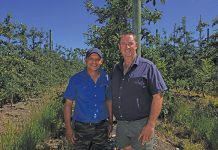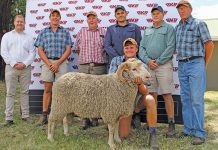The Cape Parrot (Poicephalus robustus) is SA’s rarest bird, with its global population currently listed in the SA Red Data Book and described as “endangered” by the International Union for the Conservation of Nature/ Birdlife International. Its numbers have been declining for the past 30 years, and with a mere 1 000 of them left in the wild, the species is far from safe. The tenth annual Cape Parrot Big Birding Day (CPBBD) was celebrated recently, with concerned individuals and organisations spending a weekend in the bird’s known haunts in an attempt to determine its current numbers as accurately as possible. Among them was Professor Colleen T Downs of the University of KwaZulu-Natal’s School of Biological and Conservation Services in Pietermaritzburg.
Prof Downs has been a driving force behind the ongoing efforts of the CPBBD and of the Cape Parrot Working Group, consisting of a range of stakeholders interested in conserving this species. The group works to protect wild Cape parrot populations and their habitats, and to ensure the health and safety of birds in captivity.
Their habits
“Cape parrots are associated with Afro-montane (Africa’s mountainous regions) Podocarpus (a genus of conifers that includes South African yellowwoods) forests in the Eastern Cape, KwaZulu-Natal and Limpopo province,” Prof Downs says. “It breeds in the forests that lie 1 000m above sea level. These birds are feed nomadics that move between forest patches to find food, and sometimes even reach as far as coastal forests.”
Cape parrots are specialist feeders, preferring the seed kernels of yellowwood trees. However, they are not averse to feeding on the seeds and fruit of other forest trees, such as Natal plum and white stinkwood, and will also feed in fruit and pecan orchards if there are food shortages in the indigenous forests.
The Cape parrot is loud and conspicuous, being active for a few hours after dawn and before sunset, and can be found at feeding sites in flocks ranging from 20 to 70 individuals. This flocking behaviour while feeding can create the impression that Cape parrot numbers are high, but Prof Downs says that this perception is incorrect.
The threats
“Various factors have caused the decline, and sometimes elimination, of these birds in some areas. These include forest degradation; food and nest-site shortages resulting in poor breeding success; the illegal removal of birds from the wild for the avicultural and pet trade; diseases, such as the beak and feather virus; and predation,” she explains.
Cape parrots breed in the snags (standing dead trees) of Afromontane habitats. They either chew their nesting holes out of the decomposing core, or use a suitable existing cavity in the snag. The nests are usually 6m to 12m above ground, where the female lays up to four round white eggs. Both legal and illegal loggers in these indigenous Afromontane forests remove trees that are suitable as feeding or nesting sites for the parrots. Podocarpus species live a long time, and if they are harvested and not left to die and decompose, there will not be enough nesting sites for the birds. As with most endangered species, the illegal trade in Cape parrots is a major threat to their existence in the wild. Unscrupulous dealers can command many thousands of rand for a single individual, and it is only through protective legislation and the efforts of concerned people, like Prof Downs, that this illegal trade can be minimised and the perpetrators severely punished.
“Another major threat to Cape parrots are the farmers who shoot the birds when they move into a fruit or pecan orchard,” Prof Downs points out. “If these people could appreciate how they are contributing to the possible extinction of this already extremely rare bird species, and if they could find alternative but harmless ways of chasing the parrots away from the orchards, then this problem will no longer exist.”
What to do
The CPBBD is making a worthy contribution to the protection of this species. With knowledge of Cape parrot population numbers and trends, the CPWG and other organisations have a strong platform from which to lobby the authorities to draft and enforce legislation to protect these birds. Prof Downs’ university department has already expressed hope that the Department of Environmental Affairs and Tourism’s new national regulations for threatened and protected species will bode well for the birds. Unfortunately these regulations will now only come into effect on 1 February 2008. Departmental newsletter editor Tiawanna Taylor wrote, “This means that listed species nationally will now have uniform conservation status, with the same legal standards applied across the country … These regulations list a broad range of restricted activities that will now require permits. The Cape parrot is listed within these regulations under Schedule A: Threatened Species.”
Conserving the Afromontane forests
Prof Downs believes that the conservation of the Afromontane forests in which Cape parrots live is one of the most important potential solutions to protecting these birds. “We can’t conserve the parrots without the forests,” she explains. “Overutilisation of these forests must somehow be reversed, improved policing of this natural resource implemented, and sufficient regeneration time between limited harvestings of forest resources allowed. Other ways of supporting forest conservation are establishing “Adopt a Forest” campaigns, encouraging the reforestation of denuded areas with endemic tree species, training guides to educate the public about threats to these forests and generating ecotourism enterprises that use Afromontane forest resources sustainably.” The CPWG is also currently updating the Cape Parrot Studbook and creating a Cape Parrot DNA Bank. The studbook aims to provide an accurate, up-to-date record of all Cape parrots in captivity, including pets and those in breeding programmes. Ideally the studbook should hold details of every single Cape parrot currently in captivity, plus details of birds (including those now deceased) that have bred in captivity to show the pedigree and relationship to the original founding birds. To this end, the CPWG is asking all Cape parrot owners and breeders to contact it and supply the required information. “Anybody can help by preserving existing patches of Afromontane forest, planting the necessary trees in safe locations, putting up nest boxes and participating in the annual CPBBD. They can also educate others about the plight of this species, and sponsor Cape parrot conservation efforts,” concludes Prof Downs.
Contact Prof Colleen T Downs on (033) 260 5127/04; visit the Cape Parrot Working Group website at www.cpwg.unp.ac.za; or contact the Cape Parrot Studbook on (031) 579 4600. |fw








